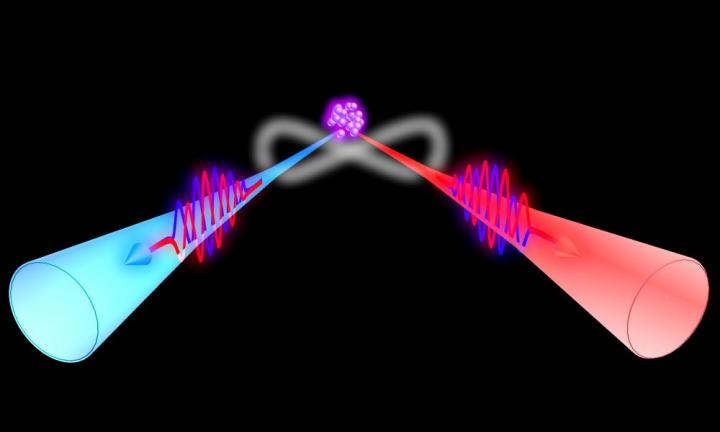Researchers demonstrated violation of Bell's inequality on frequency-bin entangled photon pairs

This is quantum entanglement. Credit: Physics Department, HKUST
Such “spooky action at a distance” seems contradictory to our common belief and, in 1935, Einstein attempted to use entanglement to criticize quantum mechanics — that the quantum description of physical reality is incomplete.
Einstein believed that no information could travel faster than light, and suggested that there might be some local hidden variable theories that could explain the world in a deterministic way, if and only if they obey realism and locality.
In 1964, J. S. Bell showed that the debate can be experimentally resolved by testing an inequality; by measuring correlations between entangled parties, the result calculated from local hidden variable theories should be constrained by the Bell inequality, which on the other hand can be violated in the prediction of quantum mechanics.
Making use of a specifically-developed slow light technique to reduce the velocity of light dramatically, researchers at the Hong Kong University of Science and Technology implemented a Bell Test and were able to generate frequency-bin entangled narrowband biphotons from spontaneous four-wave mixing (SFWM) in cold atoms with a double-path configuration, where the phase difference between the two spatial paths can be controlled independently and nonlocally.
Their findings were published in the journal Optica on April 15, 2017 (doi: 10.1364/OPTICA.4.000388).
“We tested the CHSH Bell inequality and registered |?|=2.52±0.48|S|=2.52±0.48, which violates the Bell inequality |?|?2,” said Shengwang Du, professor of Physics at HKUST and the leader of the research team.
“We have unambiguously demonstrated the generation of frequency-bin entangled narrowband (about 1 MHz) biphotons, which can efficiently interact with stationary atomic quantum nodes in an atom-photon quantum network. Because of their narrow bandwidth, these biphotons can be stored and retrieved from a quantum memory with high efficiency.”
“Our result, for the first time, tests the Bell inequality in a nonlocal temporal correlation of frequency-bin entangled narrowband biphotons with time-resolved detection,” said Xianxin Guo, a co-author of the paper. “This will have applications in quantum information processing involving time-frequency entanglement.”
The study revealed the temporal details that agree well with theory calculation based on quantum mechanics, and implies the possibility of encoding and decoding qubit information in the time domain.
“Our narrowband frequency-bin entangled biphoton source in this work can be ideally implemented to produce pure heralded single photons in a two-color qubit state with a tunable phase, making use of entanglement, linear optics, and time-resolved detection,” said Guo.
Media Contact
All latest news from the category: Physics and Astronomy
This area deals with the fundamental laws and building blocks of nature and how they interact, the properties and the behavior of matter, and research into space and time and their structures.
innovations-report provides in-depth reports and articles on subjects such as astrophysics, laser technologies, nuclear, quantum, particle and solid-state physics, nanotechnologies, planetary research and findings (Mars, Venus) and developments related to the Hubble Telescope.
Newest articles

Properties of new materials for microchips
… can now be measured well. Reseachers of Delft University of Technology demonstrated measuring performance properties of ultrathin silicon membranes. Making ever smaller and more powerful chips requires new ultrathin…

Floating solar’s potential
… to support sustainable development by addressing climate, water, and energy goals holistically. A new study published this week in Nature Energy raises the potential for floating solar photovoltaics (FPV)…

Skyrmions move at record speeds
… a step towards the computing of the future. An international research team led by scientists from the CNRS1 has discovered that the magnetic nanobubbles2 known as skyrmions can be…





















